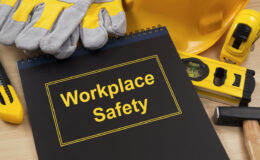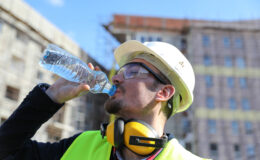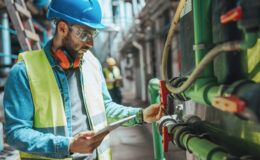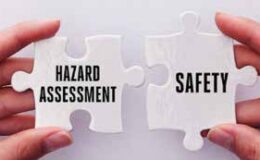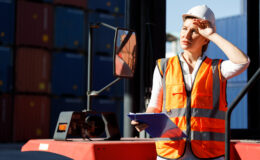By Travis Halsted, Loss Control Consultant
As the season of melting snow begins and the use of air movement fans is once again seen, it is essential to determine how the risk of trips and slips resulting in falls in the workplace can be eliminated. According to the 2009 statistics from the Bureau of Labor Statistics, 605 workers were killed and an estimated 212,760 workers were seriously injured by falls to the same or lower level (Centers for Disease Control and Prevention, 2014). Occupational fall injuries result in approximately $70 billion spent annually between medical and workers’ compensation costs (Centers for Disease Control and Prevention, 2014). From these staggering numbers the need to prevent this type of injury is high on many safety committee lists.
While seasonal changes play an intricate part in the development of slip and trip hazards there are also many other contributing factors to be aware of. Such other factors include;
- Unguarded wet floors
- Unstable walking/working surfaces
- Unprotected edges
- Holes in floors or wall openings
- Unsafely positioned ladders
- Misused fall protection
- Dry floors with wood dust or powder
- Items draped across walkways or on floor (i.e.; extension cords, air hoses)
As many trip and slip hazards can easily be prevented it is imperative to identify some key steps that employees can take to protect themselves as well as probable locations that employers can look at for these hazards. Methods to reduce the possibility of a slip or trip and fall injury include;
 1. Develop Good Housekeeping Practices. By creating and practicing good housekeeping procedures an employer can drastically reduce the risk of a slip or trip and fall. The installation of an air hose and electrical drops in lieu of extension cords can assist in eliminating the lines on the floor. If drops are not a possibility due to overhead cranes then the installation of the cord covers or protectors could also eliminate the slip or trip and fall hazard. By establishing housekeeping procedures as part of a daily routine and assigning responsibilities, employers provide the awareness to the employees of the possible hazards as well as provide them with a way to raise awareness of any issues to management.
1. Develop Good Housekeeping Practices. By creating and practicing good housekeeping procedures an employer can drastically reduce the risk of a slip or trip and fall. The installation of an air hose and electrical drops in lieu of extension cords can assist in eliminating the lines on the floor. If drops are not a possibility due to overhead cranes then the installation of the cord covers or protectors could also eliminate the slip or trip and fall hazard. By establishing housekeeping procedures as part of a daily routine and assigning responsibilities, employers provide the awareness to the employees of the possible hazards as well as provide them with a way to raise awareness of any issues to management.
 2. Create and Maintain Proper Lighting. Poor lighting in a work areas prevents employees from being able to see and react to any possible hazards. Employers should maintain proper illumination in walkways, staircases, ramps, hallways, basements, and dock areas. Areas around light switches should be kept clear and accessible.
2. Create and Maintain Proper Lighting. Poor lighting in a work areas prevents employees from being able to see and react to any possible hazards. Employers should maintain proper illumination in walkways, staircases, ramps, hallways, basements, and dock areas. Areas around light switches should be kept clear and accessible.
 3. Wear Proper Footwear. Proper footwear can play a large part in preventing falls. Employees need to wear appropriate footwear for duties and maintain a sole with proper tread and always keep their shoelaces tied.
3. Wear Proper Footwear. Proper footwear can play a large part in preventing falls. Employees need to wear appropriate footwear for duties and maintain a sole with proper tread and always keep their shoelaces tied.
 4. Reduce Wet or Slippery Surfaces. As walking surface conditions account for a large portion of slip and fall injuries it is essential that the walking surfaces are kept clean. Items to be aware of on walking surfaces are trash, metal shavings, dust, water, snow and ice, or any other debris that could be detrimental to the quality of the walking surface. The use of a wet floor sign in wet areas, antiskid tape in other troublesome areas, and proper snow/ice removal in parking lots can provide some remedies to possible hazards.
4. Reduce Wet or Slippery Surfaces. As walking surface conditions account for a large portion of slip and fall injuries it is essential that the walking surfaces are kept clean. Items to be aware of on walking surfaces are trash, metal shavings, dust, water, snow and ice, or any other debris that could be detrimental to the quality of the walking surface. The use of a wet floor sign in wet areas, antiskid tape in other troublesome areas, and proper snow/ice removal in parking lots can provide some remedies to possible hazards.
Through a thorough work area and workplace safety analysis the potential hazards for a slip and/or trip and fall hazard can be found and remedied before an injury takes place. For some other helpful hints or key factors regarding slip and trip hazards please feel free to contact our Loss Control department.
Centers for Disease Control and Prevention. (2014, 29 January). Fall Injuries Prevention In The Workplace. Retrieved from Centers for Disease Control and Prevention: http://www.cdc.gov/niosh/topics/falls/

